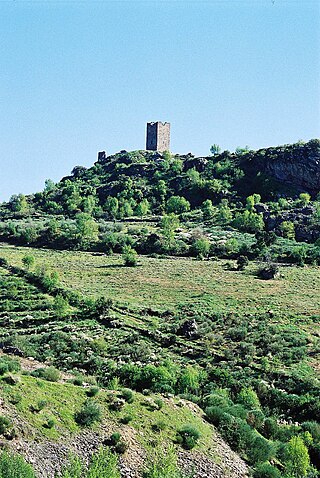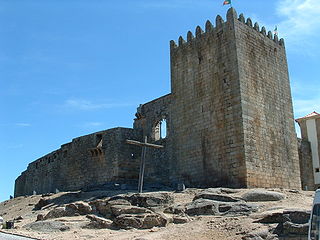
Dom Gualdim Pais, a Portuguese crusader, Knight Templar in the service of Afonso Henriques of Portugal. He was the founder of the city of Tomar.
This is a historical timeline of Portugal.

Idanha-a-Velha is a village in the civil parish (freguesia) of Monsanto e Idanha-a-Velha, in the municipality of Idanha-a-Nova, central eastern Portugal, and the site of ancient Egitânia, a former bishopric. It covers an area of 20.98 km2 and had a population of 79 as of 2001.

Melgaço is a municipality in the district of Viana do Castelo in Portugal. The population in 2011 was 9,213, in an area of 238.25 km2. It is the northernmost municipality in Portugal.

Idanha-a-Nova is a town and surrounding municipality in the district of Castelo Branco, in east-central Portugal. A border municipality with Spain, the population of the municipality in 2011 was 9,716, in an area of 1416.34 km2, making it one of the largest and least densely populated municipalities in Portugal as well as the first Portuguese municipality by population ageing. King Alfonso II (1211-1223) confirmed its charter in 1219 renaming the village with the current place names (Idanha-a-Nova) to distinguish it from the old Idanha, 18 kilometers away. The municipal holiday is the Monday 15 days after Easter. The incumbent mayor is Armindo Moreira Palma Jacinto, representing the Socialist Party.

Monsanto is a village in the civil parish of Monsanto e Idanha-a-Velha, in the municipality of Idanha-a-Nova, District of Castelo Branco, Portugal. In 2011, it covered an area of 131.76 km2 and had 828 inhabitants. Monsanto would become popularly known as "the most Portuguese village of Portugal" due to a government-sponsored competition that awarded twelve historic villages the distinction of Most Portuguese Village of their own province in 1938.

The Castle of Castelo Branco is a Portuguese medieval castle in civil parish of Castelo Branco, in the municipality of the same name, in the Centro district of Castelo Branco. Known locally as the Castelo dos Templários, the Romanesque castle was constructed under the orders of King Afonso II of Portugal in 1214.
Castelo de Idanha-a-Velha is a castle in Idanha-a-Velha, Idanha-a-Nova municipality, Portugal. It is classified as a National Monument.

The Castle of Monsanto is a medieval castle located in the civil parish of Monsanto e Idanha-a-Velha, in the municipality of Idanha-a-Nova, Portuguese district of Castelo Branco.

The Castle of Alcanede, is a Portuguese medieval castle in civil parish of Alcanede, in the municipality of Santarém, in the Ribatejo district of Santarém.
Monsanto e Idanha-a-Velha is a civil parish in the municipality of Idanha-a-Nova, Portugal. It was formed in 2013 by the merger of the former parishes Monsanto and Idanha-a-Velha. The population in 2011 was 892, in an area of 152.73 km2. Thanks to its fine collection of ruins, the village of Idanha-a-Velha has some of the country's most important archaeological sites. It stands in a place where a Roman city once lay, the capital of Civitas Igaeditanorum and later the episcopal seat during occupation by the Suebi and Visigoths. It was occupied by Muslims in the 8th century and taken back by Christians in the 12th century. It was donated to the Knights Templar in the 13th century and still has traces of different ages that attest to permanent occupation by various civilisations. Perched on a hilltop that oversees all the surrounding horizons, the village of Monsanto has a unique charm that has earned it two titles in the 20th century – the Most Portuguese Village in Portugal in 1938, a title awarded by the Portuguese Secretariat for Propaganda under the Estado Novo regime, and Historical Village in 1995. Monsanto is one of the region's main tourist attractions and offers visitors a unique experience. It was granted charters by King Afonso Henriques, King Sancho I, King Sancho II and King Manuel. The oldest part is also the highest point, where the Knights Templar built a wall with the donjon.

The Castle of Almada is a medieval castle located in the civil parish of Almada, Cova da Piedade, Pragal e Cacilhas, in the municipality of Almada, Portuguese Setúbal.

The Castle of Numão is a medieval castle in the civil parish of Numão, municipality of Vila Nova de Foz Côa, in the Portuguese district of Guarda.

The Castle of Santo Estêvão is a medieval castle located in the civil parish of Santo Estêvão, municipality of Chaves, in the Portuguese district of Vila Real. Located in a dominant position over the village, the castle is within walking distance of the course of the river Tamega and the border with Spain.

The Castle of Penas Roias is a Portuguese medieval castle in the civil parish of Penas Roias, municipality of Mogadouro, in the Portuguese of district of Bragança.

The Castle of Mogadouro is a medieval castle located in the civil parish of Mogadouro, Valverde, Vale de Porco e Vilar de Rei, in the municipality of Mogadouro, Portuguese district of Bragança.

The Castle of Belmonte is a medieval castle located in the municipality of Belmonte, Castelo Branco district in Portugal.

The Former Cathedral of Idanha-a-Velha is the decommissioned medieval Catholic cathedral of the former bishopric of Egitânia, in the Freguesia of Monsanto e Idanha-a-Velha, in the municipality of Idanha-a-Nova, in the central Portuguese district of Castelo Branco.

The Castle of Penamacor is a medieval castle located in the civil parish of Penamacor, in the municipality of Penamacor, Portuguese district of Castelo Branco.
The presence of the Knights Templar in Portugal can be traced from 1128 until their dissolution in the 14th century.


















